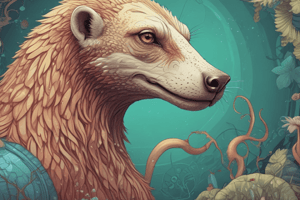Podcast
Questions and Answers
Which of the following best exemplifies how zoology contributes to addressing global challenges?
Which of the following best exemplifies how zoology contributes to addressing global challenges?
- Using bioinformatics to catalog the genetic diversity of various species.
- Classifying newly discovered insect species to expand our understanding of biodiversity.
- Studying animal physiology to develop strategies for managing disease outbreaks in livestock. (correct)
- Analyzing the migratory patterns of birds to improve aviation safety.
How has the integration of molecular data most significantly impacted modern zoological studies?
How has the integration of molecular data most significantly impacted modern zoological studies?
- It has enabled the complete sequencing of the genomes of all known animal species.
- It has refined animal classifications and helped resolve evolutionary relationships. (correct)
- It has replaced traditional methods of anatomical comparison.
- It has introduced a new approach to studying animal behavior.
What is the primary significance of the Linnaean system of binomial nomenclature in zoological taxonomy?
What is the primary significance of the Linnaean system of binomial nomenclature in zoological taxonomy?
- It provides a detailed description of the anatomical features of each species.
- It assigns each species a unique two-part name, aiding in clear and universal identification. (correct)
- It classifies animals based on their ecological roles within an ecosystem.
- It outlines the evolutionary history and phylogenetic relationships of different animal groups.
Which of the following scenarios best illustrates the application of comparative anatomy in zoological research?
Which of the following scenarios best illustrates the application of comparative anatomy in zoological research?
An ethologist observes a previously unknown behavior in a group of chimpanzees. What initial approach would best help determine whether the behavior is innate or learned?
An ethologist observes a previously unknown behavior in a group of chimpanzees. What initial approach would best help determine whether the behavior is innate or learned?
Which of the following reflects the correct order of zoological classification, from broadest to most specific?
Which of the following reflects the correct order of zoological classification, from broadest to most specific?
Desert animals often exhibit specialized physiological adaptations. Which adaptation would be most effective for water conservation?
Desert animals often exhibit specialized physiological adaptations. Which adaptation would be most effective for water conservation?
How do phylogenetic studies using molecular data enhance our understanding of animal evolution, compared to relying solely on morphological data?
How do phylogenetic studies using molecular data enhance our understanding of animal evolution, compared to relying solely on morphological data?
How might the study of animal physiology directly contribute to advancements in human medicine?
How might the study of animal physiology directly contribute to advancements in human medicine?
Which factor primarily influences the distribution and abundance of animal populations in a given ecosystem?
Which factor primarily influences the distribution and abundance of animal populations in a given ecosystem?
What distinguishes sexual reproduction from asexual reproduction in animals?
What distinguishes sexual reproduction from asexual reproduction in animals?
How does comparative genomics contribute to understanding evolutionary relationships between animal species?
How does comparative genomics contribute to understanding evolutionary relationships between animal species?
Why are model organisms like fruit flies and zebrafish valuable in zoological research?
Why are model organisms like fruit flies and zebrafish valuable in zoological research?
Which of the following techniques is most useful for visualizing cellular structures at high resolution in zoological research?
Which of the following techniques is most useful for visualizing cellular structures at high resolution in zoological research?
How can zoology contribute to food security and improved agricultural practices?
How can zoology contribute to food security and improved agricultural practices?
What role does natural selection play in the evolution of animal populations?
What role does natural selection play in the evolution of animal populations?
How are citizen science projects contributing to zoological research and conservation efforts?
How are citizen science projects contributing to zoological research and conservation efforts?
What is the primary focus of conservation biology within the broader field of animal ecology?
What is the primary focus of conservation biology within the broader field of animal ecology?
Flashcards
Zoology
Zoology
The scientific study of animals, covering anatomy, behavior, genetics, evolution, ecology, and conservation.
History of Zoology
History of Zoology
Aristotle's observations led to the classification of animals, which was then contributed by natural historians like Linnaeus and Darwin.
Animal Classification
Animal Classification
A system that classifies animals into a hierarchical system, from Kingdom to species, using binomial nomenclature.
Binomial Nomenclature
Binomial Nomenclature
Signup and view all the flashcards
Phylogeny
Phylogeny
Signup and view all the flashcards
Animal Anatomy
Animal Anatomy
Signup and view all the flashcards
Animal Physiology
Animal Physiology
Signup and view all the flashcards
Ethology
Ethology
Signup and view all the flashcards
Animal Communication
Animal Communication
Signup and view all the flashcards
Genetics
Genetics
Signup and view all the flashcards
Evolution
Evolution
Signup and view all the flashcards
Sexual Reproduction
Sexual Reproduction
Signup and view all the flashcards
Asexual reproduction
Asexual reproduction
Signup and view all the flashcards
Model Organisms
Model Organisms
Signup and view all the flashcards
Microscopy
Microscopy
Signup and view all the flashcards
Statistical Analysis
Statistical Analysis
Signup and view all the flashcards
Citizen Science
Citizen Science
Signup and view all the flashcards
Study Notes
- Zoology is the scientific study of animals.
- It encompasses the study of animal anatomy, physiology, behavior, genetics, evolution, ecology, and conservation.
- Understanding animal biology is crucial for addressing global challenges such as biodiversity loss, disease management, and food security.
History and Scope
- Zoology's roots trace back to Aristotle's observations and classifications of animals.
- The field evolved with contributions from natural historians like Linnaeus and evolutionary biologists like Darwin.
- Modern zoology is a broad discipline, incorporating molecular biology, bioinformatics, and other advanced techniques.
- It's often divided into specialized fields, such as entomology (insects), ornithology (birds), and mammology (mammals).
Animal Classification and Taxonomy
- Animals are classified into a hierarchical system, starting with broad categories like Kingdom and narrowing down to species.
- The Linnaean system uses binomial nomenclature, assigning each species a unique two-part name (genus and species).
- Phylogeny, based on evolutionary relationships, is used to understand the connections between different animal groups.
- Molecular data, such as DNA sequences, are increasingly used to refine animal classifications and resolve evolutionary relationships.
- Key animal phyla include Porifera (sponges), Cnidaria (jellyfish), Platyhelminthes (flatworms), Nematoda (roundworms), Mollusca (snails), Annelida (segmented worms), Arthropoda (insects, crustaceans), Echinodermata (starfish), and Chordata (vertebrates).
Animal Anatomy and Physiology
- Animal anatomy deals with the structure of animal bodies, while physiology focuses on how these structures function.
- Comparative anatomy examines the similarities and differences in the anatomy of different animal groups.
- Key physiological processes include respiration, circulation, digestion, excretion, and reproduction.
- Animals have diverse adaptations to their environments reflected in their anatomy and physiology.
- Desert animals, for example, have adaptations for water conservation, while aquatic animals have adaptations for efficient gas exchange in water.
Animal Behavior
- Ethology is the study of animal behavior, including how animals interact with each other and their environment.
- Animal behavior is influenced by both genetic and environmental factors.
- Key behavioral concepts include instinct, learning, communication, social behavior, and foraging.
- Behaviors can be innate (instinctive) or learned through experience.
- Communication involves the transmission of signals between animals, using visual, auditory, chemical, or tactile cues.
- Social behavior ranges from simple aggregations to complex societies with division of labor, such as those found in ants and bees.
Animal Ecology
- Ecology is the study of the interactions between organisms and their environment.
- Animal ecology focuses on how animals interact with their environment and with each other.
- Key ecological concepts include population dynamics, community structure, ecosystem function, and conservation biology.
- Animals play important roles in ecosystems as consumers, predators, prey, decomposers, and pollinators.
- The distribution and abundance of animal populations are influenced by factors such as food availability, habitat, climate, and competition.
- Conservation biology aims to protect endangered species and preserve biodiversity.
Animal Genetics and Evolution
- Genetics is the study of heredity and variation in organisms.
- Animal genetics explores the genetic basis of animal traits and how these traits are passed on from one generation to the next.
- Evolution is the process by which populations of organisms change over time.
- Natural selection is a key mechanism of evolution, where individuals with advantageous traits are more likely to survive and reproduce.
- Genetic mutations, gene flow, and genetic drift also contribute to evolutionary change.
- The fossil record provides evidence of animal evolution over millions of years.
- Comparative genomics compares the genomes of different animal species to understand evolutionary relationships.
Reproduction and Development
- Animal reproduction can be sexual or asexual.
- Sexual reproduction involves the fusion of gametes (sperm and egg) to produce offspring with genetic variation.
- Asexual reproduction involves a single parent and produces offspring that are genetically identical to the parent.
- Animal development involves a series of stages from fertilization to adulthood.
- Key developmental processes include cell division, cell differentiation, and morphogenesis.
- Embryology is the study of animal development from fertilization to birth or hatching.
Model Organisms in Zoology
- Model organisms are species that are easy to study in the lab and provide insights into broader biological principles.
- Common model organisms in zoology include fruit flies (Drosophila melanogaster), zebrafish (Danio rerio), and mice (Mus musculus).
- These organisms have been instrumental in advancing our understanding of genetics, development, and disease.
- Their relatively short generation times and ease of manipulation make them ideal for experimental studies.
Techniques in Zoological Research
- A variety of techniques are used in zoological research, including: microscopy, molecular biology techniques (e.g., PCR, DNA sequencing), field observations, behavioral experiments, and statistical analysis.
- Microscopy allows scientists to visualize cells and tissues at high resolution.
- Molecular biology techniques are used to study genes, proteins, and other molecules involved in animal biology.
- Field observations involve studying animals in their natural habitats.
- Statistical analysis is used to analyze data and draw conclusions from zoological research.
Applications of Zoology
- Zoology has many practical applications, including: medicine, agriculture, conservation, and environmental management.
- Understanding animal physiology is crucial for developing new treatments for human diseases.
- Zoology contributes to food security through improved animal breeding and disease management in livestock.
- Zoology informs conservation efforts aimed at protecting endangered species and preserving biodiversity.
- Zoology helps in managing and mitigating the impact of invasive species.
Emerging Trends in Zoology
- Genomics and bioinformatics are generating new insights into animal evolution, genetics, and ecology.
- The use of advanced imaging techniques is allowing scientists to visualize animal behavior and physiology in new ways.
- Citizen science projects are engaging the public in zoological research and conservation efforts.
- Climate change and habitat loss are major challenges for animal populations, and zoologists are working to understand and mitigate these impacts.
Studying That Suits You
Use AI to generate personalized quizzes and flashcards to suit your learning preferences.




